Key takeaways
- Storytelling in comics uniquely combines visuals and text to create immersive and emotional experiences for readers.
- Key elements include character development, pacing, world-building, and emotional engagement, all of which enhance reader connection to the narrative.
- Techniques like visual storytelling and careful pacing can amplify suspense and emotional depth, making moments more impactful.
- Recommended resources, such as “Understanding Comics” and online platforms like Webtoon and Tapas, can help comic authors refine their storytelling skills.
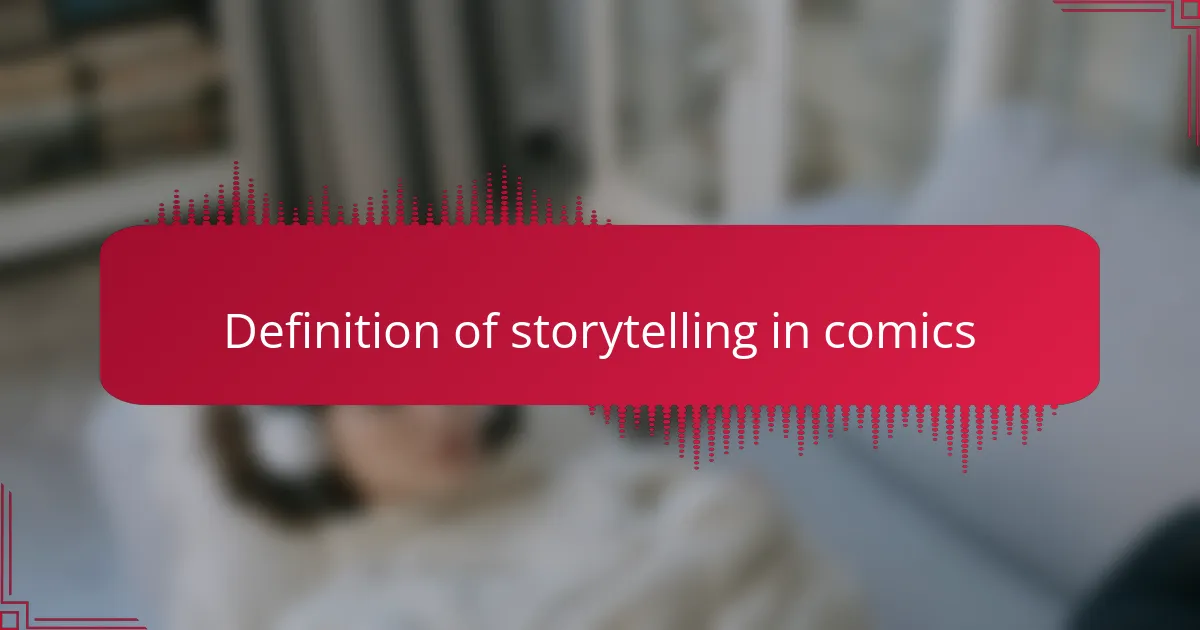
Definition of storytelling in comics
Storytelling in comics is a unique medium that blends visuals with narrative to create an immersive experience. I find that each panel comes alive with emotion, allowing readers to engage with characters and plots in a way that’s distinct from traditional literature. There’s just something about how a single image, paired with a few words, can evoke powerful feelings and convey complex ideas.
When it comes to storytelling in comics, several key elements define this art form:
- Visual Narrative: The interplay between images and text is crucial; visuals often enhance or complement the written story.
- Character Development: Characters in comics are often crafted through their visuals and dialogue, making them relatable and memorable.
- Pacing and Timing: The arrangement of panels can control the rhythm of the story, impacting how readers experience tension and release.
- World-Building: Setting is vividly portrayed through art, allowing readers to become fully immersed in diverse and imaginative worlds.
- Emotional Engagement: A well-timed visual or a striking illustration can amplify emotional responses, creating a more profound connection with the audience.
Reflecting on my experiences, I remember the joy of turning pages, feeling the weight of a character’s journey through both the text and illustrations. It’s that synergy that makes storytelling in comics truly captivating.
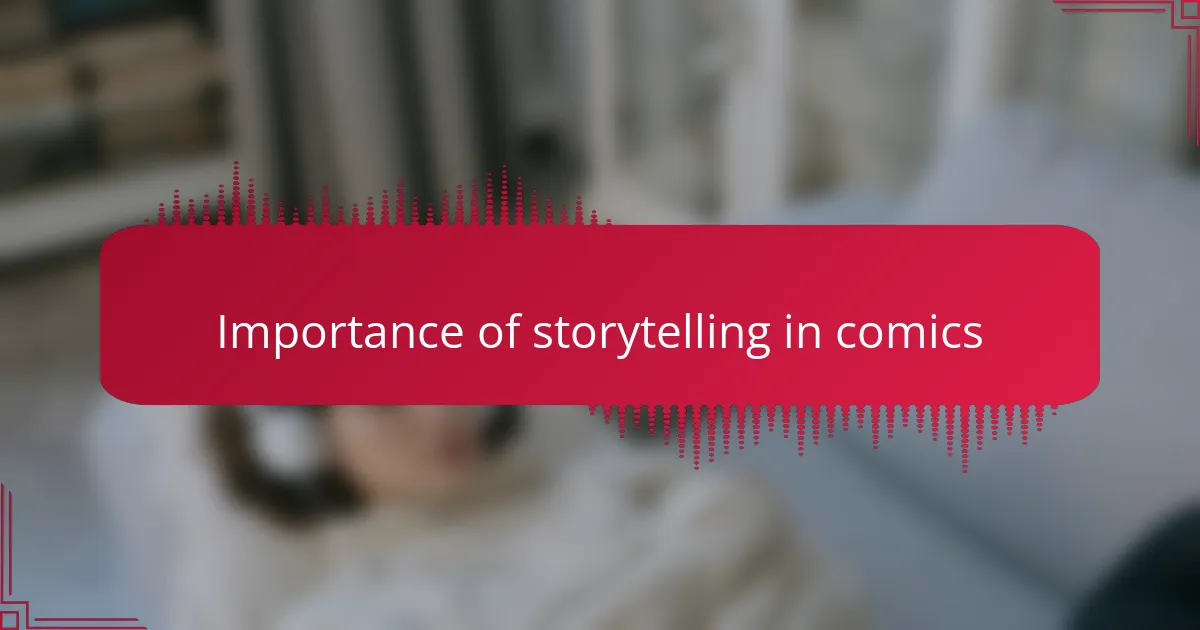
Importance of storytelling in comics
When I think about storytelling in comics, I realize just how vital it is for creating a memorable experience. Each story is more than just the sum of its panels and dialogues; it’s about crafting a world that resonates with readers. I still remember being swept away by the adventures of Spider-Man when I was a kid. The thrill of seeing how his visual journey unfolded alongside the written narrative kept me turning pages long into the night.
Emotional engagement is another cornerstone of storytelling that I’ve come to appreciate. A well-drawn panel can capture a character’s grief or joy in a way that words often cannot. For example, when I see a character’s expression change within a single frame, it instantly draws me in. Have you ever felt that rush of connection when a comic captures a fleeting moment perfectly? That’s the beauty of storytelling in this medium—something I cherish deeply.
Moreover, pacing and timing in comics often dictate how effectively a story lands. I’ve noticed that the arrangement of panels can create suspense or even laughter, making me pause to absorb what just happened. It’s fascinating how the rhythm of a comic can mirror real life so closely, allowing readers to feel the weight of action and consequence. For me, each turn of the page is an opportunity to feel, reflect, and connect with the storytelling on a personal level.
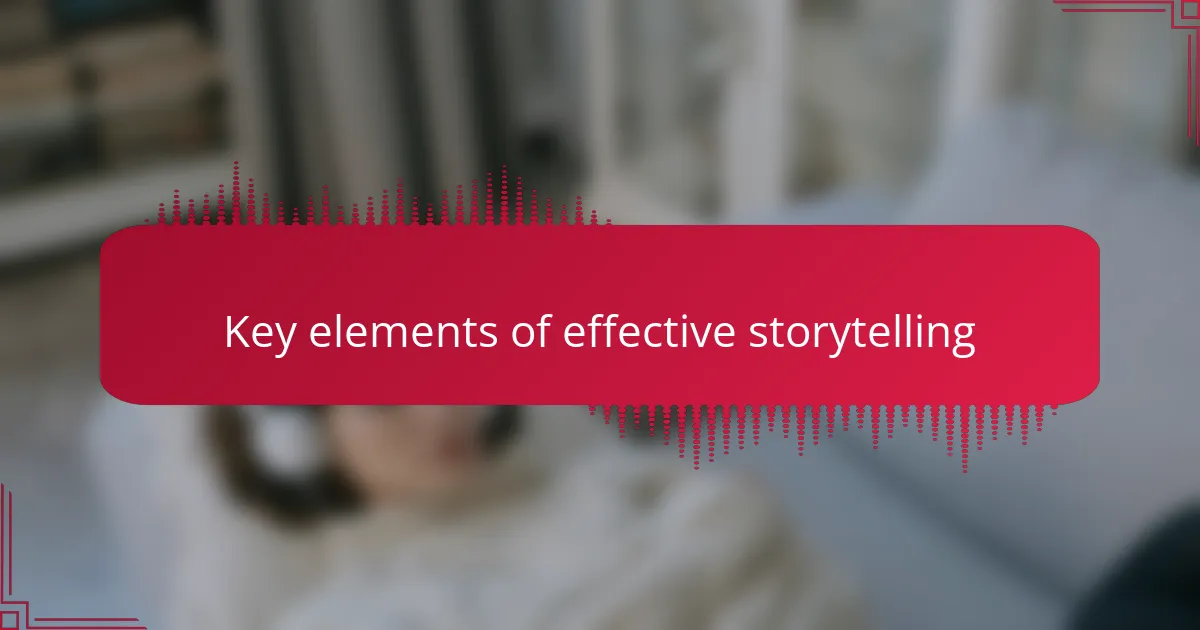
Key elements of effective storytelling
When it comes to visual narrative in comics, the synergy between images and text is essential. I remember a specific moment when I read a comic where a character’s expression spoke louder than the accompanying dialogue. That’s the magic of this medium; in just one panel, you can convey emotions that might take paragraphs to describe. Have you ever paused to admire a scene because the artwork perfectly matched the storyline? It’s those moments that create lasting impressions.
Character development is also pivotal in effective storytelling. Through unique designs and authentic dialogue, characters can leap off the page, becoming real to the reader. I often find myself deeply invested in characters who feel like friends, sharing in their triumphs and challenges. Have you ever felt a hollow ache at a character’s loss or a rush of joy at their victory? It’s this kind of connection that makes us return to our favorite comics time and time again.
Lastly, pacing and timing play a critical role in shaping the reading experience. The strategic placement of panels can manipulate the flow of a story, drawing the reader in and keeping them on edge. I once read a comic where a sudden change in pacing transformed a serene moment into an unexpected thrill. Did it ever strike you how a sudden action scene can send your heart racing? It’s elements like this that highlight the intricate dance between storytelling and how we, as readers, engage with the plot.
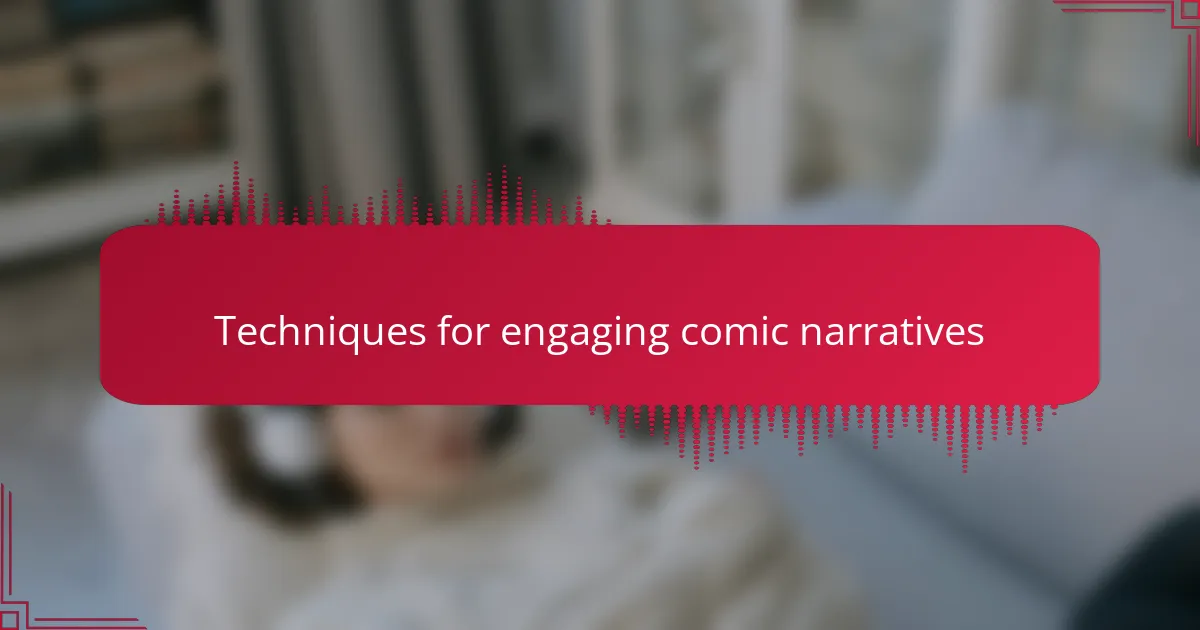
Techniques for engaging comic narratives
When it comes to engaging comic narratives, pacing is crucial. In my experience, carefully timed panel transitions can create tension and highlight emotional beats. For example, I once crafted a scene where a character paused before revealing a secret. The silence stretched across several panels, which allowed readers a moment to anticipate the reveal, amplifying their emotional investment.
Another technique that I find effective is the use of visual storytelling. Comics are a unique medium that allows for a fusion of words and images, which can convey layers of meaning. I’ve often included subtle visual cues—like a character’s shifting gaze or small background details—to foreshadow events or emotions. Readers appreciate the depth these details add, making them feel rewarded for paying attention.
- Use pacing to build suspense and enhance emotional depth.
- Incorporate visual cues to provide subtext and foreshadowing.
- Create dynamic panel layouts to reflect character emotions or themes.
- Employ dialogue that feels authentic and drives the plot forward.
- Integrate humor or levity to balance heavier themes when appropriate.
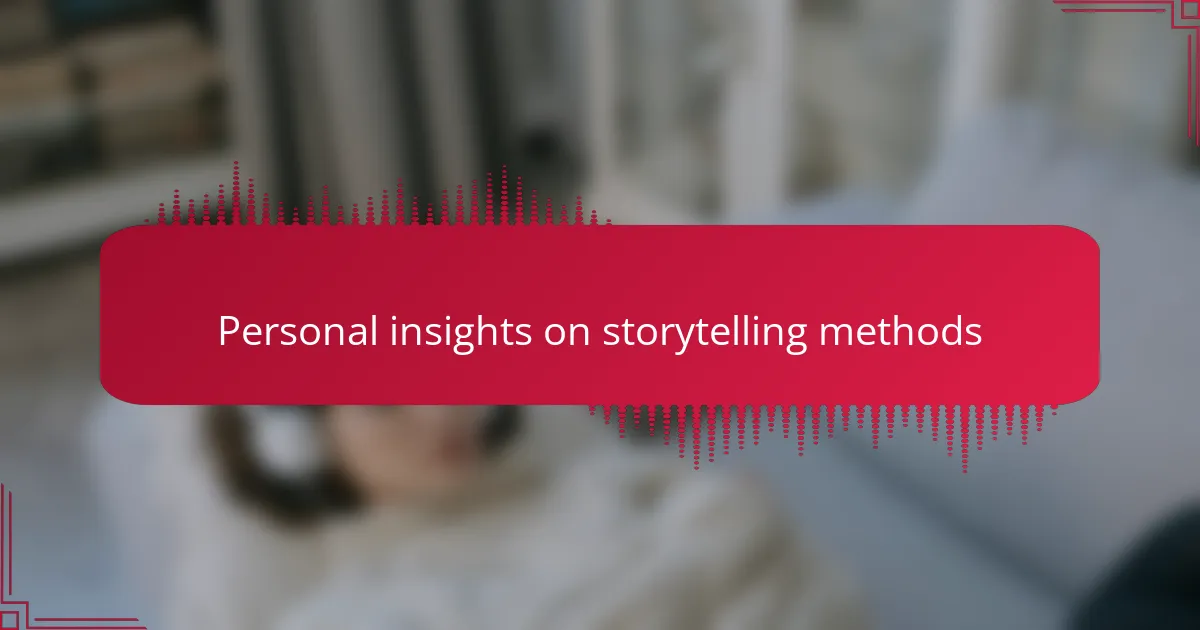
Personal insights on storytelling methods
I often think about how the pacing of a comic can shape a reader’s emotions. For instance, there was a time when I read a comic that expertly stretched a simple conversation over several panels, manipulating time and anticipation. As I flipped through, I found myself hanging on every word; it felt as if I were sharing the moment with the characters. Have you had that experience where time seemingly slows down within a story? It’s incredible what a few extra seconds can do for building tension.
Character development, for me, is deeply intertwined with visual style. I remember being captivated by a character whose design reflected their personality so well that it felt like I had known them forever. Those details—like the way a superhero’s cape flows or how a villain’s shadow looms—can tell stories of their own. It makes me wonder, how often do we overlook the visual nuances that enrich the narrative? Such artistry can engage readers on a level beyond the dialogue.
Moreover, there’s a unique power in using visual cues for storytelling. I’ve often used background elements to hint at an unfolding plot twist. One comic I wrote had a seemingly innocuous item in the background that later became pivotal to the story. It was thrilling to see readers’ reactions when they connected those dots. Do you ever notice things in the background that enrich your understanding of a story? Those layers can elevate a comic from good to unforgettable, creating a richer experience for the reader.

Recommended resources for comic authors
When it comes to storytelling in comics, I find that the right resources can truly enhance a creator’s craft. I’ve often turned to books like “Understanding Comics” by Scott McCloud, which dives deep into the mechanics of the medium. This book not only provides practical insights but also encourages you to think critically about how visuals and text work together.
In my experience, online communities can be invaluable. Websites like Webtoon and Tapas allow you to see diverse styles and storytelling techniques. I’ve learned so much simply by reading others’ works and participating in discussions. Seeing how different creators approach storytelling has broadened my perspective and fueled my own creativity.
Here’s a table comparing some useful resources for comic authors:
| Resource | Type |
|---|---|
| Understanding Comics | Book |
| Webtoon | Website |
| Tapas | Website |
| The Complete Guide to Self-Publishing Comics | Book |
| Comic Book Herald | Blog |
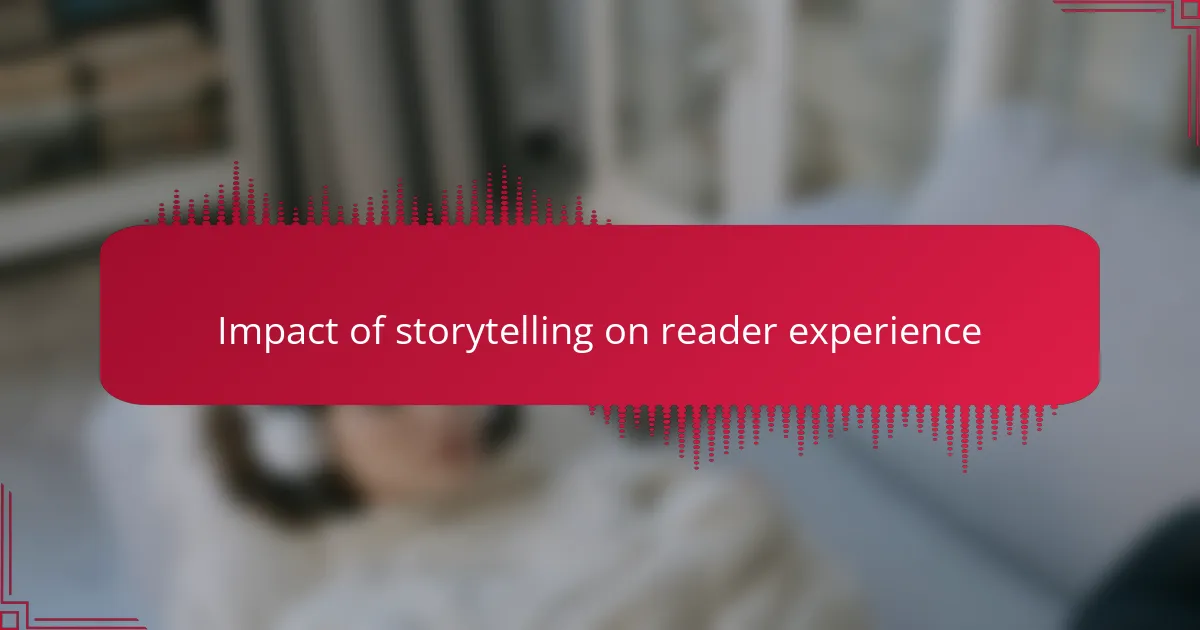
Impact of storytelling on reader experience
Storytelling in comics is a powerful tool that can deeply affect the reader’s experience. I’ve noticed how well-crafted narratives can transport me into worlds I never imagined. For instance, a comic that combines vivid visuals with thoughtful character development can evoke a spectrum of emotions, from joy to heartbreak. It’s not just about the pictures; it’s about how they resonate with the story.
Another pivotal aspect is the pacing. In my experience, a story that masterfully balances action with quiet moments allows readers to breathe and reflect, enhancing their overall connection to the narrative. I remember reading a comic where the slower scenes made the shocking moments even more impactful. That contrast kept me hooked and made me feel like a part of the journey.
Here’s a comparison of different storytelling techniques and their impact on reader experience:
| Technique | Reader Impact |
|---|---|
| Visual Storytelling | Engages through imagery, creating an immediate emotional response. |
| Dialogue | Builds character depth and fosters a connection through relatable conversations. |
| Pacing | Controls tension; allows for moments of reflection and anticipation. |
